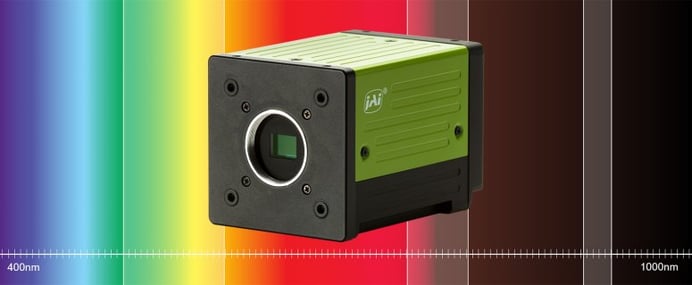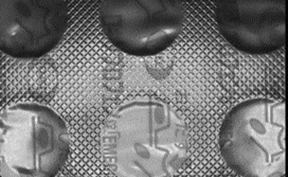
JAI is now introducing Flex-Eye – a new and innovative camera concept giving vision system designers the ability to customize the size and location of wavebands in JAI's Fusion Series 2-CMOS and 3-CMOS prism-based multispectral cameras.
By combining the Flex-Eye customization process with our existing Fusion Series prism-based cameras, vision system designers can now tailor make a multispectral camera that looks at specific visible and near infrared waveband ranges to meet the exact requirements of their vision applications.
Using Flex-Eye, vision system designers will be able to customize the spectral locations and widths of the individual wavebands if the default wavebands of JAI’s Fusion Series standard models do not quite fit their specific requirements.
This new approach will make vision inspection tasks or other multispectral imaging applications even more efficient and productive because a 2-CMOS or 3-CMOS camera fine-tuned to look at targeted wavebands (designed for a particular application) can reveal new and additional imaging information that otherwise can be hidden.
Fusion Flex-Eye sets a completely new standard in multispectral imaging:
Fusion Series Flex-Eye cameras offers a very large number of different customization combinations and will therefore be the ideal camera in several different vision applications where multispectral imaging is being used today, but where new waveband combinations can lead to new or improved capabilities. The flexibility now provided with Flex-Eye sets a new standard in the multispectral imaging field - and is only available from JAI.
A few of the most common application areas are:
- Fluorescence-guided surgery, pathology, or other life sciences applications.
- Food and vegetable sorting/inspection.
- Agriculture and vegetation analysis or weed removal systems.
- Package inspection, especially printed plastic packages.
- Multi-layer electronic circuit board inspection.

Crop health, intelligent farming, environmental studies… |

Surgical guidance, life sciences, forensics… |

Electronics, recycling, scientific research… |

Inspection of fruits, vegetables, nuts, grains, tea leaves… |

Currency inspection, passports, biometrics… |

Pharmaceuticals, cosmetics, and their packaging… |
Based on JAI's proven standard Fusion Series cameras...
The new Fusion Series Flex-Eye cameras share the same high performance capabilities of the standard Fusion Series models. The standard Fusion Series models are prism-based multispectral area scan cameras equipped with two or three Sony Pregius CMOS sensors offering either 1.6 megapixels or 3.2 megapixels of resolution and a set of predefined wavebands – one that spans the entire visible spectrum (400-700 nm) and one or two additional wavebands located in the NIR region (700-1000 nm). A dichroic prism divides the incoming light to the separate sensors while maintaining a common optical path. This affords simultaneous capture of all wavebands with high frame rates and perfect pixel-to-pixel alignment enabling the cameras to handle movement and fine details that might cause problems for other types of multispectral cameras.
....and now with the possibility to be customized:
With the addition of Fusion Flex-Eye, users can now customize the spectral locations and widths of the individual wavebands to better suit the needs of their application, rather than accepting the default wavebands in the standard models. Depending on the user's requirements, the two or three user-specified wavebands can all be located within the visible spectrum or can be placed at multiple locations across the 400-1000 nm range.
Models equipped with three 3.2-megapixel sensors can run at up to 107 fps at full resolution while cameras with two 3.2-megapixel sensors can deliver up to 123 fps. For models with three 1.6-megapixel sensors, the maximum rate at full resolution is 213 fps and with two 1.6-megapixel sensors it's 226 fps.
A customization project is started with the on-line Fusion Flex-Eye camera configurator
As part of Flex-Eye customization process, JAI has developed an online configurator that makes it easy for customers to define and visualize their custom configuration on PCs or mobile devices.
A few clicks or taps specifies the number of sensors, the resolution, and whether Bayer or monochrome sensors are to be used in the visible spectrum.
Then an intuitive GUI lets users place, stretch, or shrink their wavebands on a simple spectral chart. Wavebands as narrow as 25 nm are supported, and built-in validation rules help to guide the user to a working configuration.

A Fusion multispectral camera customization project is started with the on-line Fusion Flex-Eye camera configurator. Go to the on-line Flex-Eye configurator and get started. 
High throughput of the cameras supported by a 10GBASE-T (10 GigE) interface:
The high throughput of the cameras is supported by a 10GBASE-T (10 GigE) interface equipped with integrated auto-negotiation technology, providing automatic backwards compatibility to NBASE-T (5 Gbps and 2.5 Gbps) and traditional 1000BASE-T (1 Gbps) output for customers running vision applications on these lower-speed Ethernet standards. In addition to 8-bit output, the cameras can provide 10-bit and 12-bit output, with synchronous or asynchronous operating modes across the multiple sensors.
The 10 GigE interface complies with the GigE Vision 2.0 standard and uses a multi-stream approach over a single cable to efficiently provide the multispectral wavebands for separate analysis or for combining on the host processor. The interface also supports the Precision Time Protocol (IEEE 1588) to enable network-level synchronization in multi-camera systems.
Learn more about the Fusion Flex-Eye concept:
Learn more about the Fusion Flex-Eye multispectral camera concept and try out the on-line Fusion Flex-Eye configurator.
Learn more about the Fusion Flex-Eye camera models:
More product highlights, specifications and datasheets for each of the Fusion standard and Fusion Flex-Eye models are available on the Fusion Series Section
Download Tech Guide: Multispectral imaging:
Download this FREE tech guide about multispectral imaging for medical and industrial machine vision systems.
Watch webcast: Using prism-based cameras for multispectral applications:
If you are a vision system designer with a project that needs multispectral imaging capability, this free webinar can help you decide whether a prism-based multispectral camera is the right approach. There are several different types of multispectral cameras currently available and the one you select can have a major impact on your project’s success.
Contact JAI for additional information and help:
If you want to discuss your vision application before trying the Fusion Flex-Eye configurator you are welcome to contact JAI for a talk and additional information :
